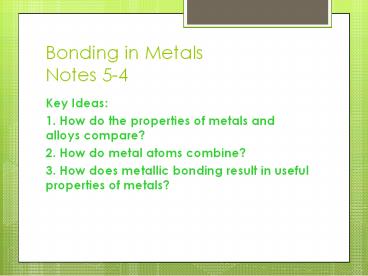Bonding in Metals Notes 5-4 - PowerPoint PPT Presentation
1 / 3
Title:
Bonding in Metals Notes 5-4
Description:
Bonding in Metals Notes 5-4 Key Ideas: 1. How do the properties of metals and alloys compare? 2. How do metal atoms combine? 3. How does metallic bonding result in ... – PowerPoint PPT presentation
Number of Views:53
Avg rating:3.0/5.0
Title: Bonding in Metals Notes 5-4
1
Bonding in MetalsNotes 5-4
- Key Ideas
- 1. How do the properties of metals and alloys
compare? - 2. How do metal atoms combine?
- 3. How does metallic bonding result in useful
properties of metals?
2
Metals and Alloys
- An alloy is a mixture made of two or more
elements, at least one of which is a metal. They
are generally stronger and less reactive than the
pure metals from which they are made. - Physical Properties
- Pure gold shiny and soft
- Gold alloys still shiny but much harder (mixed
with copper or silver) - Chemical Properties
- Pure iron rusts when exposed to air and water
- Iron alloy stronger, resists rust (mixed with
one or more other elements to make steel) - Are hard, brittle crystals a characteristic
that results from a metallic bond? - No!!!
3
Metallic Bonding and Metallic Properties
- Bonds
- Metal atoms combine in regular patterns in which
the valence electrons are free to move from atom
to atom (think of metal atoms floating in a sea
of electrons). - Each metal ion is held in place by a metallic
bond - an attraction between a positive metal ion
and the many electrons surrounding it. (The more
valence electrons, the stronger the bond.) - 5 Properties
- Malleability easily rolled into sheets or made
into complex shapes - Ductility easily bent or pulled into wires
- Luster shiny and reflective
- Electrical Conductivity conduct electricity
easily (because electrons move freely) - Thermal Conductivity conduct heat easily
(because electrons move freely)































